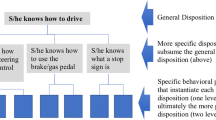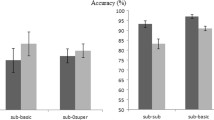Abstract
The ability to group perceptual objects into functionally relevant categories is vital to our comprehension of the world. Such categorisation aids in how we search for objects in familiar scenes and how we identify an object and its likely uses despite never having seen that specific object before. The systems that mediate this process are only now coming to be understood through considerable research efforts combining neurological, psychological and behavioural studies. What is much less well understood are the differences between the categories, how they are formed and how they are used by experts and non-experts in a complex task that can take decades to master. In a quite different direction to previous studies, this work infers the different categorical structures that might be used by amateurs and professionals in the oriental game of Go. This is achieved by using a newly developed combination of artificial neural networks (Self-organising Maps) and perceptual inference to show that categories of strategic scenes can be learned while playing games using a model of ‘conditional perceptual learning’. Applying this technique to two databases of games, one of amateurs and one of professionals, shows that a structural hierarchy of scene information develops that can be readily incorporated into traditional psychological models of decisions and readily implemented in computational systems. The results are discussed in terms of the heuristics and biases literature, emphasising where the significant similarities and differences lie between this work and previous work.









Similar content being viewed by others
Explore related subjects
Discover the latest articles, news and stories from top researchers in related subjects.Notes
A full set of rules and a complete description can be found at http://senseis.xmp.net/.
From the KGS Go server: http://www.gokgs.com.
Taken from the commercial GoGod database, Winter 2009 version: http://www.gogod.co.uk.
The unique function both finds the unique vectors in S a and S p (and thereby generates \(S^{\tilde{a}}\) and \(S^{\tilde{p}}\)) and also sorts them in ascending order.
References
Afraz, S. R., Kiani, R., & Esteky, H. (2006). Microstimulation of inferotemporal cortex influences face categorization. Nature, 442(7103), 692–695.
Alecu, L., Frezza-Buet, H., & Alexandre, F. (2011). Can self-organisation emerge through dynamic neural fields computation? Connection Science, 23(1), 1–31.
Atherton, M., Zhuang, J., Bart, W. M., Hu, X., & He, S. (2000). A functional magnetic resonance imaging study of chess expertise. In Poster session presented at the annual meeting of the Cognitive Neuroscience Society, San Francisco.
Atherton, M., Zhuang, J., Bart, W. M., Hu, X., & He, S. (2003). A functional MRI study of high-level cognition. I. The game of chess. Cognitive Brain Research, 16(1), 26–31.
Bejjanki, V. R., Beck, J. M., Lu, Z. L., & Pouget, A. (2011). Perceptual learning as improved probabilistic inference in early sensory areas. Nature Neuroscience, 14(5), 642–648.
Benner, P., & Tanner, C. (1987). How expert nurses use intuition. The American Journal of Nursing, 87(1), 23.
Bilalić, M., McLeod, P., & Gobet, F. (2007). Does chess need intelligence?a study with young chess players. Intelligence, 35(5), 457–470.
Bilalić, M., McLeod, P., & Gobet, F. (2008). Expert and “novice” problem solving strategies in chess: Sixty years of citing De Groot (1946). Think Reasoning, 14(4), 395–408.
Brockmole, J. R., Castelhano, M. S., & Henderson, J. M. (2006). Contextual cueing in naturalistic scenes: Global and local contexts. Journal of Experimental Psychology 32(4), 699.
Campitelli, G., & Gobet, F. (2004). Adaptive expert decision making: Skilled chessplayers search more and deeper. Journal of the International Computer Games Association, 27(4).
Cavanagh, P. (2011). Visual cognition. Vision Research, 51(13), 1538–1551.
Charness, N., Reingold, E. M., Pomplun, M., & Stampe, D. M. (2001). The perceptual aspect of skilled performance in chess: Evidence from eye movements. Memory & Cognition, 29(8), 1146–1152.
Chase, W. G., & Simon, H. A. (1973). Perception in chess. Cognitive Psychology, 4(1), 55–81.
Chassy, P., & Gobet, F. (2011). A hypothesis about the biological basis of expert intuition. Review of General Psychology, 15, 198–212.
Chun, M. M., & Jiang, Y. (1998). Contextual cueing: Implicit learning and memory of visual context guides spatial attention. Cognitive Psychology, 36(1), 28–71.
Cottrell, M., & Verleysen, M. (2006). Advances in self-organizing maps. Neural Networks, 19(6), 721–722.
De Groot, A. D., Gobet, F., & Jongman, R. W. (1996). Perception and memory in chess: Studies in the heuristics of the professional eye. The Netherlands: Van Gorcum & Co.
Ericsson, K. A. (2008). Deliberate practice and acquisition of expert performance: A general overview. Academic Emergency Medicine, 15(11), 988–994.
Ericsson, K. A., Prietula, M. J., & Cokely, E. T. (2007). The making of an expert. Harvard Business Review, 85(7/8), 114.
Fahle, M. (2002). Perceptual learning. Encyclopedia of cognitive science. New York: Wiley.
Fiser, J., Berkes, P., Orbán, G., & Lengyel, M. (2010). Statistically optimal perception and learning: From behavior to neural representations. Trends in Cognitive Science, 14(3), 119–130.
Garrigan, P., & Kellman, P. J. (2008). Perceptual learning depends on perceptual constancy. Proceedings of the National Academy of Sciences of the United States of America, 105(6), 2248.
Gobet, F., & Jackson, S. (2002). In search of templates. Cognitive Systems Research, 3(1), 35–44.
Gobet, F., & Simon, H. A. (1996a). Recall of random and distorted chess positions: Implications for the theory of expertise. Memory & cognition, 24(4), 493–503.
Gobet, F., & Simon, H. A. (1996b). Templates in chess memory: A mechanism for recalling several boards. Cognitive Psychology, 31(1), 1–40.
Gobet, F., Lane, P. C. R., Croker, S., Cheng, P. C. H., Jones, G., Oliver, I., et al. (2001). Chunking mechanisms in human learning. Trends in Cognitive Science, 5(6), 236–243.
Goldstone, R. L. (1998). Perceptual learning. Annual Review of Psychology, 49(1), 585–612.
Grossberg, S. (1994). Letter to the editor: Physiological interpretation of the self-organizing map algorithm. CAS/CNS Technical Report Series, (026).
Guida, A., Gobet, F., Tardieu, H., & Nicolas, S. (2012). How chunks, long-term working memory and templates offer a cognitive explanation for neuroimaging data on expertise acquisition: A two-stage framework. Brain Cognition, 79(3), 221–244.
Hamamé, C. M., Cosmelli, D., Henriquez, R., & Aboitiz, F. (2011). Neural mechanisms of human perceptual learning: Electrophysiological evidence for a two-stage process. PloS One, 6(4), e19221.
Harré, M., & Snyder, A. (Eds.). (2011). Intuitive expertise and perceptual templates. Minds and Machines, 22, 167–182. doi:10.1007/s11023-011-9264-9
Harré, M. S., Bossomaier, T., Gillett, A., & Snyder, A. (2011a). The aggregate complexity of decisions in the game of Go. The European Physical Journal B, 80(4), 555–563.
Harré, M., Bossomaier, T., & Snyder, A. (Eds.). (2011b). The development of human expertise in a complex environment. Minds and Machines, 21, 449–464. doi:10.1007/s11023-011-9247-x
Harré, M., Bossomaier, T., & Snyder, A. (2012). The perceptual cues that reshape expert reasoning. Scientific Reports, 2, 502.
Heekeren, H. R., Marrett, S., & Ungerleider, L. G. (2008). The neural systems that mediate human perceptual decision making. Nature Reviews Neuroscience, 9(6), 467–479.
Kahneman, D., & Klein, G. (2009). Conditions for intuitive expertise: A failure to disagree. American Psychologist, 64(6), 515.
Kellman, M. (2011). The heuristics debate. Oxford: Oxford University Press.
Klein, G. A. (1999). Sources of power: How people make decisions. New York: The MIT Press.
Klein, G., Calderwood, R., & Clinton-Cirocco, A. (2010). Rapid decision making on the fire ground: The original study plus a postscript. Journal of Cognitive Engineering and Decision Making, 4(3), 186–209.
Kohonen, T. (1982). Self-organized formation of topologically correct feature maps. Biological Cybernetics, 43(1), 59–69.
Kohonen, T. (1993). Physiological interpretation of the self-organizing map algorithm. Neural Networks, 6(7), 895–905.
Kohonen, T., & Hari, R. (1999). Where the abstract feature maps of the brain might come from. Trends in Neurosciences, 22(3), 135–139.
Kourtzi, Z. (2010). Visual learning for perceptual and categorical decisions in the human brain. Vision Research, 50(4), 433–440.
Lee, B., Park, J. Y., Jung, W. H., Kim, H. S., Oh, J. S., Choi, C. H., et al. (2010). White matter neuroplastic changes in long-term trained players of the game of “Baduk” (GO): A voxel-based diffusion-tensor imaging study. Neuroimage, 52(1), 9–19.
Ma, W. J., Navalpakkam, V., Beck, J. M., van den Berg, R., & Pouget, A. (2011). Behavior and neural basis of near-optimal visual search. Nature Neuroscience, 14(6), 783–790.
Masunaga, H., Kawashima, R., Horn, J. L., Sassa, Y., & Sekiguchi, A. (2008). Neural substrates of the topology test to measure fluid reasoning: An fmri study. Intelligence, 36(6), 607–615.
Navon, D. (1977). Forest before trees: The precedence of global features in visual perception. Cognitive Psychology, 9(3), 353–383.
Nisbett, R. E., & Wilson, T. D. (1977). Telling more than we can know: Verbal reports on mental processes. Psychological Review, 84(3), 231.
Nosofsky, R. M. (1986). Attention, similarity, and the identification–categorization relationship. Journal of Experimental Psychology: General, 115(1), 39.
Oliva, A. (2005). Gist of the scene. Neurobiology of Attention, 251–256.
Oliva, A., & Torralba, A. (2006). Building the gist of a scene: The role of global image features in recognition. Progress in Brain Research , 155, 23–36.
Oliva, A., & Torralba, A. (2007). The role of context in object recognition. Trends in Cognitive Sciences, 11(12), 520–527.
Palmeri, T. J., & Gauthier, I. (2004). Visual object understanding. Nature Reviews Neuroscience, 5(4), 291–303.
Palmeri, T. J., Wong, A. C. N., & Gauthier, I. (2004). Computational approaches to the development of perceptual expertise. Trends in Cognitive Sciences, 8(8), 378–386.
Pizzi, R., Cino, G., Gelain, F., Rossetti, D., & Vescovi, A. (2007). Learning in human neural networks on microelectrode arrays. BioSystems, 88(1-2), 1–15.
Reingold, E. M., Charness, N., Pomplun, M., & Stampe, D. M. (2001). Visual span in expert chess players: Evidence from eye movements. Psychological Science, 12(1), 48–55.
Salzman, C. D., & Newsome, W. T. (1994). Neural mechanisms for forming a perceptual decision. Science, 264(5156), 231.
Sasaki, Y., Nanez, J. E., & Watanabe, T. (2009). Advances in visual perceptual learning and plasticity. Nature Reviews Neuroscience, 11(1), 53–60.
Seger, C. A., & Miller, E. K. (2010). Category learning in the brain. Annual Review of Neuroscience, 33, 203–219.
Shepard, R. N. (1957). Stimulus and response generalization: A stochastic model relating generalization to distance in psychological space. Psychometrika, 22(4), 325–345.
Shepard, R. N. (1987). Toward a universal law of generalization for psychological science. Science, 237(4820), 1317–1323.
Simon, H. A. (1992). What is an explanation of behavior? Psychological Science, 3(3), 150.
Tetlock, P. (2005). Expert political judgment: How good is it? How can we know? New Jersey: Princeton University Press.
Thibodeau, P. H., & Boroditsky, L. (2011). Metaphors we think with: The role of metaphor in reasoning. PloS One, 6(2), e16782.
Torralba, A., Oliva, A., Castelhano, M. S., & Henderson, J. M. (2006). Contextual guidance of eye movements and attention in real-world scenes: The role of global features in object search. Psychological Review, 113(4), 766.
Tromp, J., A., & Farnebäck, G. (2007). Combinatorics of Go. Computers and Games, 4630, 84–99.
Vesanto, J. (1999). Som-based data visualization methods. Intelligent Data Analysis, 3(2), 111–126.
Vesanto, J., Himberg, J., Alhoniemi, E., Parhankangas, J., Team, S. O. M. T., & Oy, L. (2000). Som toolbox for matlab. Helsinki: Techn. Ber., Helsinki University of Technology.
Walther, D. B., Caddigan, E., Fei-Fei, L., & Beck, D. M. (2009). Natural scene categories revealed in distributed patterns of activity in the human brain. Journal of Neuroscience, 29(34), 10573–10581.
Wiemer, J. C. (2003). The time-organized map algorithm: Extending the self-organizing map to spatiotemporal signals. Neural Computation, 15(5), 1143–1171.
Zhao, X., Li, P., & Kohonen, T. (2011). Contextual self-organizing map: Software for constructing semantic representations. Behavior Research Methods, 43(1), 77–88.
Acknowledgments
This work was supported by US Airforce Grant AOARD 104116.
Author information
Authors and Affiliations
Corresponding author
Rights and permissions
About this article
Cite this article
Harré, M.S. From Amateur to Professional: A Neuro-cognitive Model of Categories and Expert Development. Minds & Machines 23, 443–472 (2013). https://doi.org/10.1007/s11023-013-9305-7
Received:
Accepted:
Published:
Issue Date:
DOI: https://doi.org/10.1007/s11023-013-9305-7




